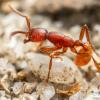
To make "ant bread" the harvester ants first shell the seeds. Ants on garbage duty take the shells to the garbage pile outside of the nest. The younger nurse ants hold the soft part of the seed in their front two legs and chew with their mandibles making a fluffy paste. This paste is eaten by larvae and ants in need of a quick snack between tasks. It's stored in the nursery so that hungry larvae can be fed as soon as they start "clicking" for food. Larvae signal that they want food by clicking their tiny mandibles (yes they have mandibles!)
Many ants will feed larvae mostly liquids, but harvester larvae can eat more solid food. This could be a bit of ant bread placed on the larvae's tummy so she can much away on her own (like a baby bottle) or a small insect like a fruit fly which they larvae will eat (except for wings) whole. I have hardly ever seen harvesters doing trophallaxis with their larvae. Just one nurse ant can keep a whole room fed more easily. Maybe it's why they reproduce so quickly.
Carpenter ants must feed each larvae individually. Harvesters pass out baby bottles to the whole nursery. Their workers are a similar size, but harvester colonies grow faster even when both have functionally unlimited* food.
What do you think? Is this similar to your observations?
*I'm yet to find the upper limit of how much food my harvesters will accept! Until I expand their nest space I'm being a little cautious so they don't get over crowded. They eat ALL of everything they are given.
















